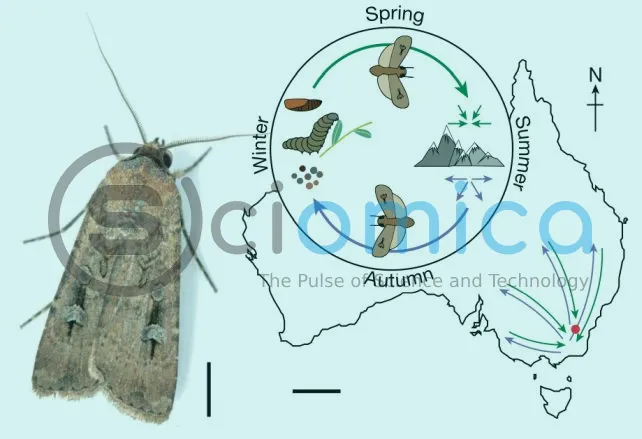
Every year, billions of bogong moths embark on a remarkable migration across Australia, a journey that sees them travelling up to 1,000 kilometers (620 miles) to the cool caves of the Australian Alps. Research shows that these nocturnal travelers possess a unique ability to navigate using the stars, a discovery that has captivated scientists.
As spring warms the Australian landscape, the bogong moths (Agrotis infusa) leave their previous habitats and fly toward regions they have never visited before. Once they reach the alpine caves, the moths enter a state of dormancy known as aestivation, waiting through the scorching summer months until they disperse again in autumn to breed. The phenomenon raises intriguing questions about how the moths manage to navigate this arduous route, particularly considering their relatively short lifespan of just one year.
New research reveals part of the answer: bogong moths can accurately navigate using the night sky. “In our study, we show that bogong moths can use the starry sky (without any additional cues) to fly in that migratory direction,” explained Andrea Adden, a neuroscientist at the Francis Crick Institute in the UK. This shows that the winged migrants can fly towards a specific destination over long distances while effectively correcting their course.
The annual flight of these moths can be a spectacular sight, as they fly for hours, stopping to rest in small crevices during the day. In some areas, towns may find themselves carpeted with resting bogong moths as they make their way to the alpine caves, with the migration spanning several nights.
Animal navigation can utilize a variety of cues. While many species rely on visual landmarks or the Earth’s magnetic field, researchers had previously suggested that bogong moths employed a combination of both. However, these latest findings indicate that the moths’ reliance on magnetism might not be as critical as once thought. A series of experiments conducted by a team from Lund University demonstrated that when placed in a controlled magnetic environment, the moths continued to fly in a seasonally appropriate direction, suggesting that they are indeed using stellar navigation.

In further investigations, the researchers used a Helmholtz coil system to eliminate the Earth’s magnetic field while displaying different starry skies in a vacuum chamber. Results indicated that moths responded consistently to the projected images, with certain neurons in their brains registering activity when stimulated by the stars.
“We were surprised to find that about 28 of the recorded neurons responded specifically to changes in the orientation of the starry sky,” noted senior author Eric Warrant. This observation emphasizes not only the importance of directional flight but also how effectively moths can compensate for factors like celestial rotation and crosswinds during their lengthy journeys.

The researchers emphasize that understanding how bogong moths navigate remains a critical field of study. As Adden explained, “We are starting to work on how the moths know when to stop, examining sensory cues associated with their destinations.” This ongoing research aims to further illuminate the intriguing mix of magnetic and stellar information processing that these small but mighty insects employ.
Bogong moths are not alone in their celestial navigation; this skillset is seen across the animal kingdom, ranging from humans to various species of birds. However, the ability of a tiny moth with a wingspan of just 5 cm to travel such long distances using the stars is undoubtedly fascinating. “Imagine trying to walk such a distance at night, without food or shelter, without any navigational aids,” Warrant remarked, captivated by the marvel of these migratory insects.
The findings have been published in Nature, marking a significant advancement in our understanding of animal navigation and the resilience of the bogong moth.







